Last Updated on November 3, 2021
The cooling system of a car may seem to work fine without any additional equipment attached to it but that will not save the cooling system of your car from any environmental damage like rust due to the way coolant works in a radiator.
Rust can be formed inside the cooling system of your car due to air getting into the radiator after the engine has cooled down.
When the coolant cools after the engine has been turned off, it contracts in volume which will result in a drop of temperature and pressure inside the radiator allowing the air to enter the radiator through the radiator cap.
Related: Overfilled Your Coolant? (What Can Happen)
That air will result in the formation of rust in the cooling system when it comes into contact with the metal in the system.
When rust has formed inside the radiator, you will have no choice but to flush out the system and replace the antifreeze. However, a radiator coolant overflow tank can prevent this problem before it even starts. This saves you the expense of frequent coolant replacements and possibly the expensive cost replacing a radiator or other components of the cooling system.
See Also: Losing Coolant But No Leaks (What to Do)
How a Radiator Overflow Tank Works
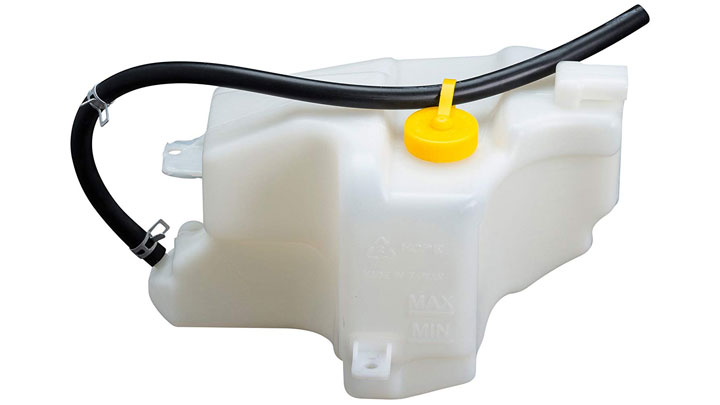
The radiator overflow tank is fairly simple device but it can save you a lot of money by preventing rust from forming in the cooling system of your car. When the engine is running at its optimum performance, it needs the engine coolant to keep it within the operational temperatures.
The engine coolant absorbs the heat from the engine. When this coolant heats in the radiator, it begins to expand causing an increase in the pressure in the cooling system of that vehicle.
When the pressure of the coolant in the radiator surpasses the designed pressure of the radiator cap, the antifreeze passes the radiator cap seal and flows into the coolant reservoir overflow tank through the overflow tube.
See Also: Is It OK to Top Off Coolant With Water?
When the engine has been turned off, the coolant will start to cool down as well. As it cools down, it will contract in volume as well. This decrease in volume will result in a vacuum because of a drop in pressure.
Due to this vacuum, a vacuum valve in the radiator cap opens allowing the coolant which was flown into the radiator coolant overflow tank back into the radiator.
In older vehicles with no coolant overflow bottle, the air is sucked into the radiator instead of coolant which results in the formation of rust. So installing an overflow tank in your car is a good way to not only maintain the cooling system of your car but to save repairs and replacement expenses in the long run as well.

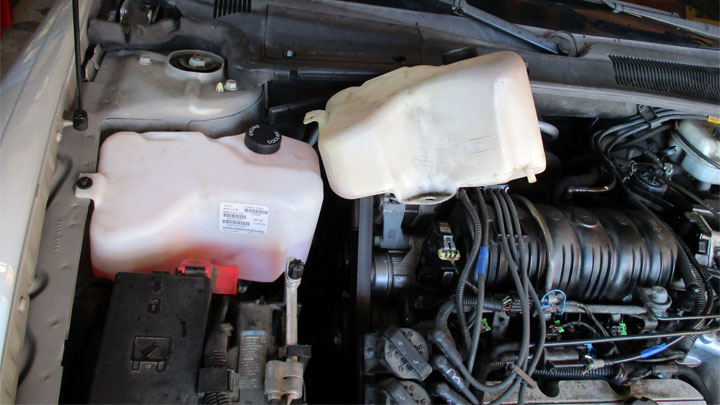
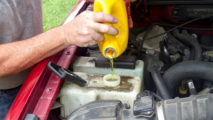
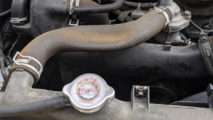
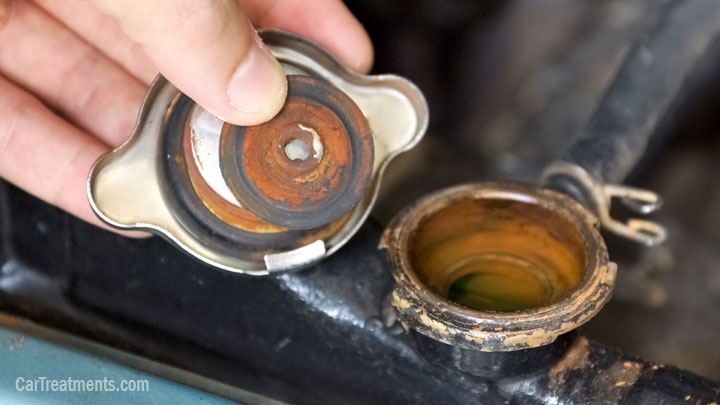
Great article. Thank you. Quick question; if the coolant overflow tank cap doesn’t have a good seal, or is missing, can this cause engine to slowly overheat? Is the coolant overflow tank part of the whole cooling system pressurized system? Thanks
The coolant tank overflow is non-pressurized on almost all modern vehicles (if the cap is plastic, it’s non-pressurized). That said, as coolant heats up it expands. So if you don’t have a tight seal, coolant can leak out and ultimately cause you to be low on coolant which would cause overheating. Check your coolant level and if you notice the level decreasing, get that cap replaced asap.
If you have air in the system will putting antifreeze in the overflow correct this?
Probably not; air likes to collect at the highest point in the system, and this point will vary depending on the vehicle. To properly bleed the system, the antifreeze level must be as high or higher than this point, which sometimes requires using a funnel in the radiator filler neck or the bleeder valve, if equipped.
As the cooling system comes up to operating temperature, it pressurizes. The job of the overflow tank is to allow excess antifreeze to leave the cooling system once peak pressure is reached, and return once the pressure decreases again.
I have Hyundai sonata Y20 the radiator cap is missing and got overheated I replaced it with a new cap with pressure indicator of 0.9 and am still experiencing overheating. Please what should be the correct radiator cap pressure to use for this car.
Hi Mohammed, I am not sure if 0.9 is the correct cap for your vehicle. A quick google of “hyundai sonata y20 radiator cap pressure” tells me that your car may need a 16 lb cap, which would be about 1.1 bar. Confirm with your local auto parts store, owner’s manual, or repair manual to be sure you have the correct pressure rating.
Thank you so much I have replaced it with 1.1bar cap but still experiencing the overheating. However when I take out the cap and cover the radiator tank with polythene with rubber band I don’t experience the overheating
I would take the vehicle to a mechanic you trust in the area to get it checked out.
So it is normal not to have any fluid in the coolant overflow when the car is cold?
Generally no. The coolant reservoir should be filled between the “low” and “full” marks. Details for your specific car should be covered in the owner’s manual.
i have a 1949 Cheve Suburban with a stock 350 small block out of a 1975 caprice. I am running an electric fan on the radiator and an electric fan on the ac condenser. The radiator is a 4 row unit and cools well. when running the ac the motor temp rises to 195 degrees when i shut it off i get overflow from the radiator. If i put a recovery tank on the truck what cap pressure should I use?
You should probably be using whatever cap pressure is recommended on a stock 75 Caprice.
Hi! I just bought a 1967 Chevy II Nova with a 283ci V8. The radiator has a pressure release hose under the cap but there is no coolant overflow tank so when it gets hot the coolant just pukes onto the ground. I am looking at different universal tanks online and see some with two valves (one for in, one for out) and other tanks with just one valve (for both in and out). Which is best? How does the one-valve tanks work? Wouldn’t they build up too much pressure?
Should coolant be added to the overflow tank or the radiator. I have an 2001 Nissan Xterra.
Top off the radiator, then top off the overflow reservoir to the full line. Make sure you only do this when the engine is completely cool. It is very dangerous to remove the radiator cap while the system is hot and pressurized. Verify that you’re using the correct coolant.
You’ll also want to burp the radiator to make sure there aren’t any trapped air pockets. Add more coolant as needed during this process. For an example of how to do this, you could google something like “2001 Nissan Xterra burp radiator”. Some people call this “bleeding” instead of burping.
My mechanic is saying that my 2002 Honda Accord’s radiator is leaking, though the reservoir is not (so while the reservoir is full, the radiator itself is low on coolant). I got the radiator replaced last year, but this is my first time at this shop. I’m just wondering how valid of a concern this is and how much it will affect vehicle performance? I’ve been driving it for the past year without anything unusual showing up on the temp gauge.
If your radiator leaks too much, your car will eventually overheat. Some cars can leak a lot of coolant before any symptoms arise, but once you overheat an engine you are at risk of much bigger problems, such as warped heads and cracked blocks that will require expensive engine work or replacement.
With some temperature gauges, the needle only starts to move off center once your engine gets dangerously hot. In other words, they really don’t give you a lot of time to notice and respond to the overheating condition.
I’ve got an aftermarket aluminum radiator in my 69 Camaro, was wondering if adding a overflow bottle of some kind would be a good idea. If I did, does the bottle position or height relative to the radiator make any difference? And if I do install one, can I add a little more coolant to the radiator or do I still leave a couple of inches empty on top? Do I stick with the 15# cap that came with the radiator? TIA-Mike
I have a Toyota 4runner 2004 and I want to know if I should add coolant to my overflow tank or radiator? Also after driving for a while, I noticed the coolant rises in the overflow tank and when left to cool off, the coolant level in the overflow tank drops most times below the full mark. What do you advice I do? Thanks in anticipation
The radiator should always be full, and the overflow reservoir should be between the low and full lines. The owner’s manual should tell you whether you should check this hot or cold. If it doesn’t specify, it probably doesn’t matter either way.
Remember not to check the pressurized cooling system while the engine is hot!
Hi! I just bought a 1967 Chevy II Nova with a 283ci V8. The radiator has a pressure release hose under the cap but there is no coolant overflow tank so when it gets hot the coolant just pukes onto the ground. I am looking at different universal tanks online and see some with two valves (one for in, one for out) and other tanks with just one valve (for both in and out). Which is best? How does the one-valve tanks work? Wouldn’t they build up too much pressure?
This is a repeat, but please answer it as I have the same question.
I am not very familiar with older cooling systems and have never set up a universal overflow tank, so I’m not really able to offer any advice on which tank is best. I would check Nova owners forums to see if there is a common setup that works well for your vehicle, or if any owners have come up with an alternative approach.
I have a Harrier car model 2000, 2.1 cc. This day I noticed that the heat gauge goes to half, the electtical fun will not run. The coolant in the radiator goes to the reserve coolant tank and the radiator remains without coolant and this happens if the vehicle is hot. But if the vehicle is cooled down, some coolant returns in the radiator
Is the radiator full of coolant?
Hi, I use a 1999 Camry but recently I noticed that the level of water in my radiator has dropped so I can’t view it & also drained water in my reserve tank. What could have caused this please?
Sounds like you have a coolant leak somewhere. You’ll need to determine where the leak is coming from, or risk overheating the engine. Before you drive anywhere, make sure you top off the coolant in both the radiator and the coolant reservoir.
Do you see anything leaking under the car? Evaporated coolant may leave white streaks or a sweet smell in the engine bay. If your coolant is leaking internally, you may see white smoke out of the exhaust. See this article for more info: https://cartreatments.com/white-smoke-from-exhaust/
Don’t open the radiator cap while the engine is hot.
I have a 93 dodge Dakota with a six cylinder engine radiator has no overflow bottle just a dump line can I add an overflow bottle? If so are there any recommendations or where to mount it high or low?
You should be able to add an overflow bottle, yes. I think those trucks came with one from the factory. Try searching “1993 Dodge Dakota coolant reservoir” and see what comes up. You should be able to mount it in the factory location.